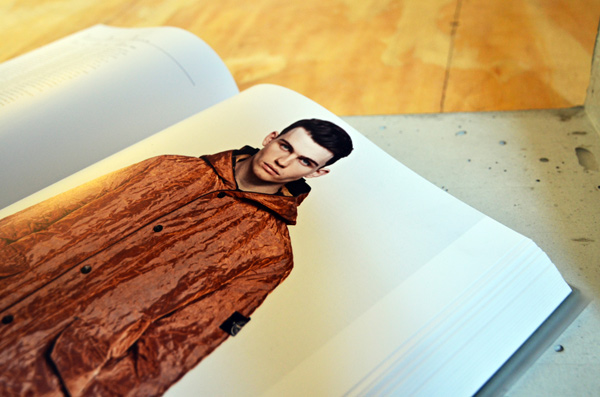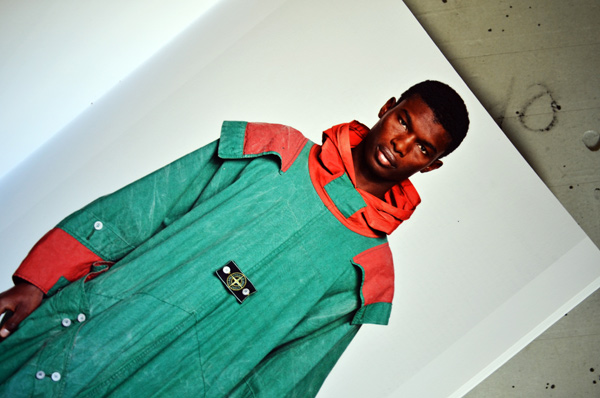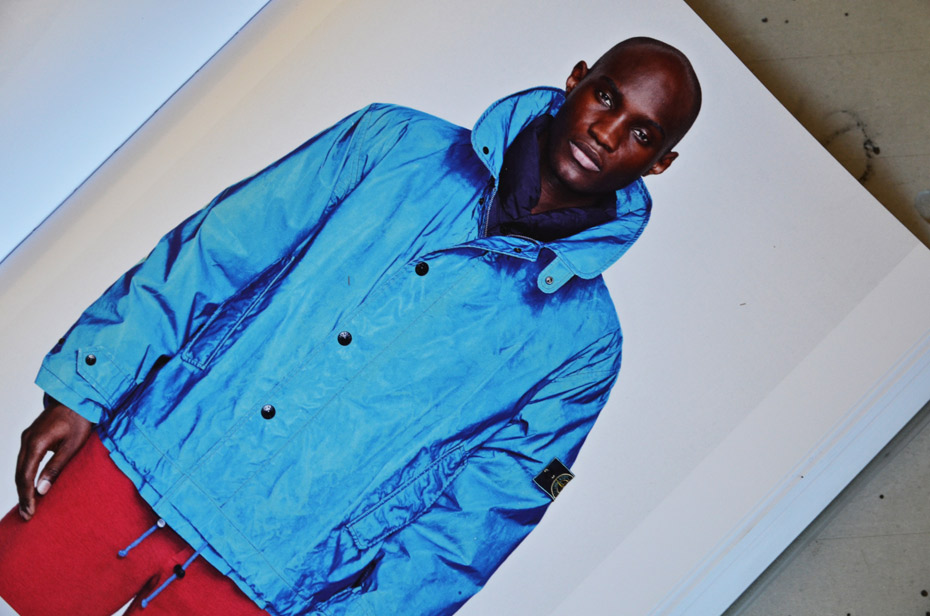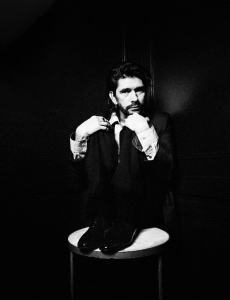- David Hellqvist talks to Stone Island Creative Director Carlo Rivetti on their 30th anniversary about how they continually push the boundaries of technology
Earlier this year, Stone Island celebrated 30 years of fabric research and sartorial development with a massive retrospective at Pitti Uomo in Florence. Buyers, press and fans came partly to pay their respect to founder Massimo Osti but also to marvel at over 200 pieces of fashion history. Wedged somewhere between industrial design, technologic science and fashion, the Italian brand and its Creative Director, Carlo Rivetti, has pushed the boundaries and inspired other designers for three decades with a wonderful mix of reflective jackets, colour changing coats, nylon metals and techno mesh materials. Now, to finish off a vintage year of jubilation, the inevitable book is out.

Left: Pure metal, shell bronze men’s jacket, STONE ISLANDStone Island Archivio ‘982-‘012 nicely bookends the brand’s journey so far by looking closer and describing some its Greatest Hits. Put together by long time collaborators Simon Foxton and Nick Griffiths it’s the perfect epilogue to the anniversary exhibition and a brilliant prelude to another 30 years of Stone Island.
David Hellqvist: How and when did you get involved with Stone Island?
Carlo Rivetti: Massimo Osti founded Stone Island in 1982. I joined the business a year later. After Massimo, I asked Paul Harvey to design the brand and he successfully did that for 12 years. In 2008, I took as Creative Director. I believed that times had changed and that it was no longer right to have one only designer. I gathered a multicultural group of designers in order to better translate the identity of the brand and to carry on with our conceptual ideas.David: Where did the name ‘Stone Island’ come from?
Carlo: Stone Island was born, almost by chance, based on a fabric – a reversible truck tarpaulin cloth, resin-treated red on one side, blue on the other – that had nothing to do with the clothing world. We tried to create a garment with it, but it turned out to be too stiff. So we put it through an extreme stone wash. The result was surprising, unlike anything we had seen before: a substantial yet soft fabric, with a worn and highly appealing appearance, extremely unusual. The result, Tela Stella, was such an incredible innovation that we developed it into a collection of seven coats and jackets in six different colours. The strong identity of this project, so different from all the rest, also needed a name. The name was found in two English words that were coming up repeatedly in Joseph Conrad’s novels: Stone and Island.

 David: After 30 years of Stone Island, what impact has the brand had on fashion?Carlo: A friend once made a very interesting analogy; Stone Island is to the garment business what Oakley is to sunglasses. When the first Oakley products appeared on the market, they changed the rules of the game. They were uniquely themselves. When the first Stone Island jackets appeared in store windows, no one had seen anything like them before.
David: After 30 years of Stone Island, what impact has the brand had on fashion?Carlo: A friend once made a very interesting analogy; Stone Island is to the garment business what Oakley is to sunglasses. When the first Oakley products appeared on the market, they changed the rules of the game. They were uniquely themselves. When the first Stone Island jackets appeared in store windows, no one had seen anything like them before.
David: What are the biggest challenges you face going forward?
Carlo: Never stop! Carrying on looking forward, keeping the correct the approach, passion and energy!
David: Looking back, what fabric development, research or invention are you the most proud of?
Carlo: It’s not a textile that makes me the most proud. In June this year, to celebrate the brand’s anniversary, we produced STONE ISLAND 30 – a three week long retrospective exhibition in Florence in collaboration with the Pitti Discovery Foundation.David: Can you describe the exhibition?
Carlo: It was set up in the amazing Stazione Leopolda, a 2,500 square meter dismissed mid-19th century train station. The exhibition included over 200 pieces from the archives, divided in 10 thematic areas representing the innumerable treatments, tests and processes that were required to create them.
Entering and walking through the exhibition, to me, was very emotional. I saw the continuity and coherency within the Stone Island brand very clearly. It made me feel really proud.
Above: Denim Badge, men’s jacket, STONE ISLAND.
David: Do you see Stone Island as a fashion house? How do you define the brand?
Carlo: We feel closer to the industrial design world rather than the fashion industry. Our garments are conceived as design items, in which functionality and research are fundamental. We look to fashion in a lateral way, driven by different stimulus. Stone Island is research, experimentation, function and use. It’s a sportswear brand that carries on an ongoing investigation, thorough and without frontiers, on the processing and ennobling of fibres and textiles, leading to discover materials and production techniques never used before in the clothing industry.

 David: Do you have an all-time favourite Stone Island piece?Carlo: No, I can’t choose but every season I have my own knit piece – they ‘re called the ‘President Knits’, they are full zip knits that you can wear as a jacket, as they all have a protective detachable lining inside. Season after season we implement them with different materials and technologies.
David: Do you have an all-time favourite Stone Island piece?Carlo: No, I can’t choose but every season I have my own knit piece – they ‘re called the ‘President Knits’, they are full zip knits that you can wear as a jacket, as they all have a protective detachable lining inside. Season after season we implement them with different materials and technologies.
.
.
.Left: Tella Stella 30th Anniversary, men’s jacket STONE ISLAND

Above: Reflective men’s jacket, STONE ISLANDDavid: What’s development process like?
Carlo: We do tests on dyeing and treatments in our internal colour laboratory. It’s a department able to combine advanced technology, experience and human knowledge, and it has developed more than 60,000 different dyeing recipes throughout the years. We study the uniform and the workwear world. Our archive is a strong point of reference. I believe that the insatiable curiosity of sounding the present and the tension towards possible futurescenarios are the conditions for Stone Island’s continuous evolution.
David: In your opinion, what’s the next step in fabric research, where do we go from here?
Carlo: We are studying materials used in the car industry. This is one of the possible future scenarios.
Stone Island Archivio ‘982-‘012 out now
Subscribe to Port Magazine annually and receive each issue to your door.
Get PORT in print



